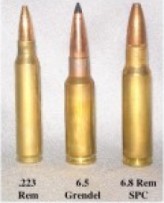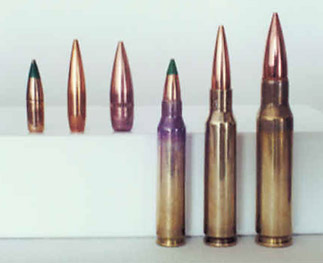We have seen numerous discussions about alternatives to 5.56 since it was adopted nearly fifty years ago. Alternatives to the .308 and 30-06 have also seen on-and-off initiatives since at least the development of the .276 Pedersen about eighty years ago. One can ask “Why do the debates continue in the face of little or no movement to new cartridges?”
One reason is that we humans are built to look for newer, better, things and to put forward defenses of our ideas. This is good. Another reason is that valid arguments suggest that the 5.56 NATO leaves a lot to be desired, even for the role it was originally intended to fill. The cartridge has done well enough largely because our fighting doctrine emphasizes combined arms where grenades, mortars, artillery, armor, aviation and air power almost relegate the rifle to a self-defense role.
The combined arms doctrine has served this country very well in the initial phases of conflict where movement dominates the combat scene. The doctrine also superbly supports static defenses where the enemy makes a concerted effort to overrun small and intermediate units as well as major positions. This doctrine, however, has limitations in protracted conflicts where small unit operations predominate.

Many battle rifles chambered for the 7.62X51 NATO can be economically re-barreled in new calibers for expanded roles. (Photo courtesy of POF-USA http://www.pof-usa.com/p308/p308.htm )
One of the major limitations results from the dilution of resources in supporting dispersed multiple squad and platoon-level engagements where only a few (sometimes just one) enemy combatants engage our soldiers. The profligate use of indirect fires in these engagements has significant costs both in terms of dollars and credibility in today’s world. The cost is especially significant when the adversary engages from within groups of noncombatants in and around homes, schools, religious facilities and so on with the expectation that we will be less likely to return fire for fear of causing lots of collateral casualties.
Turning to precision engagements helps, with the rifle being among the most precise in both accuracy and extent of effect. In debating what the rifle should become to better fill this need, we often hear arguments to the effect that the “vast majority” of engagements happen at ranges of less than 200 or 300 meters. The problem is that the average infantry unit all too frequently engages with adversaries at ranges significantly greater than average. Indeed a large fraction of the engagements happen between 300 to 600 meters.

The 6.5 Grendel and 6.8 Remington SPC have been presented as replacements for the 5.56 NATO (Cartridges courtesy of J&R Sports, Livermore, CA) © Las Positas Group, LLC
The engagements at longer ranges are accomplished with snipers, machine guns, grenade launchers, precision weapons, or indirect fires, including aviation and airpower. Of course, indirect fire is occasionally used closer to our troops but these are more emergency situations than the norm. The need for applying force at the intermediate ranges of 300 to 600 meters is currently filled by assigning a soldier to act as a designated marksman1 trained to engage enemies with rapid, precise fire over these distances.
We need to outfit the designated marksman with more capable ammunition with equipment that can use the same ammunition that his squad mates use. The inclusion of the 5.56 Mk262 77 gr Sierra Matchking ammunition goes a long way to satisfying this need. The problem is that even the Mk262 terminal effectiveness is significantly less capable than that of the 7.62 NATO. So the larger ammunition type still gets humped along by soldiers who feel they need the added punch.
Most of the serious 5.56 replacement candidates, e. g., 6.5 Grendel and 6.8 SPC, have focused on mid-power cartridges. These initiatives have, to date, failed. A consistent rationale for this failure is that they don’t offer the power needed to be clearly superior to the 5.56 NATO while remaining within the magazine length offered by the AR-15 class of rifles.
Another argument posed for avoiding these cartridge candidates have been that the larger case diameter reduces the number of rounds available. We also desire to avoid another cartridge type in the logistics train. Of these two, the logistics argument is both the most telling and the source of a way forward.
These factors suggest that we consider ammunition that replaces both the 5.56 and 7.62 NATO ammunition in the squad, platoon, and perhaps in more universal roles. The differences in weight and bulk between the AR15 and M4 class of rifles and the equivalent battle rifles is not particularly significant. So, we can ask ourselves: “Why not go with a full-length cartridge that has the perforation and penetration potential of the 7.62X51 NATO but with a smaller diameter case?”
What do we mean by “potential?” The science of terminal ballistics tells us that the ability of a bullet to perforate a thin barrier like a steel plate is driven by the kinetic energy density, bullet construction, and barrier properties. Penetration through thick barriers like sandbags shifts these factors to momentum density, bullet construction, and barrier properties. Of course, the behavior is characterized by somewhat different formulas. As an aside for another discussion, a bullet that is a good penetrator is not always a good perforator.

The 6mm Optimum is an example of proposed replacements for the 5.56 and the 7.62NATO cartridges (reprinted by permission of Stan Crist)
Recall that the principal focus of the debates has been on the inability of the 5.56 NATO round to reliably prevent an enemy combatant to do his duty at ranges of 200-600 meters.. In the present exercise, this ability is viewed as a function of the size of the permanent wound channel2. The permanent wound channel is generally proportional to the diameter of the bullet, its length when tumbling, and the extent of mushrooming or spread of fragments in a bullet that breaks up. Methodology for estimating the potential of a particular bullet to relative to other bullets of the same construction is described in the next installment.
The principal metrics for alternative cartridges then become the wounding potential, energy, and momentum density . The new ammunition type should have the same wounding potential at 600 meters as does the M855 5.56 round at 24 meters. The replacement cartridge should also be able to launch bullets with the weight and velocity needed to have penetration and perforation potentials equal or better those of the M80 7.62X51 cartridge.
Other metrics include the range over which the line soldier doesn’t need to adjust sights or sight picture to assure a hit on an adversary and the ability to incapacitate one when hit. Even though some candidates may have impressive muzzle velocities, any new cartridge is unlikely to show a significant increase in point blank range over that of the 7.62X51.
Weight being a critical factor, we are pressured to go with smaller calibers than 7.62mm, with the 5.56 through 6.5 mm diameters being especially interesting. Cases with water capacities of 40 to 45 grains of water appear to have the potential of pushing these bullets fast enough to provide the potential for penetration, perforation, and incapacitation to be seen as viable replacement candidates for the 7.62X51. We can obtain this internal volume in 51 mm long cases with body diameters on the order of those of the 6.8 mm SPC and the 6.5mm Grendel and, possibly, even smaller.
The impact on soldier loads would be that the number of rounds for the .422” and smaller base diameters in the 30-round length AR-15 magazine would go to 25 or 26 and that the weight would remain within that of the 20 round AR-10 magazine.
This is a lot of capability. A cartridge of this description may have the potential for filling the roles of both the 5.56mm and and the 7.62X51. We will explore these questions more closely in future articles.
1 A monograph by Major Thomas P. Ehrhart, United States Army, Increasing Small Arms Lethality in Afghanistan: Taking Back the Infantry Half-Kilometer (http://www.dtic.mil/cgi-bin/GetTRDoc?AD=ADA512331&Location=U2&doc=GetTRDoc.pdf) covers this topic from both a historic and doctrinal point of view.
2Martin Fackler, MD discusses these relationships in “What’s Wrong with the Wound Ballistics
Literature, and Why” ( http://rkba.org/research/fackler/wrong.html ).

Leave a Reply
You must be logged in to post a comment.